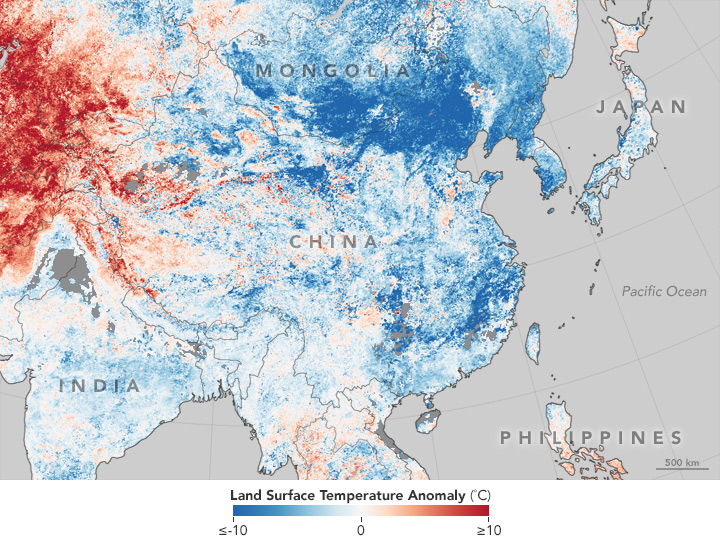


In January 2016, a deep chill descended across eastern Asia. In China, for example, more than 20 weather stations reported record-low temperatures. Other countries with tropical or subtropical climates—Taiwan, Japan, Thailand, and Vietnam—also saw temperatures plummet.
This temperature anomaly map is based on data from the Moderate Resolution Imaging Spectroradiometer (MODIS) on NASA’s Terra satellite. It shows land surface temperatures (LSTs) from January 17–24, 2016, compared to the 2001–2010 average for the same eight-day period. Red colors depict areas that were hotter than the average; blue colors were colder than average. White pixels were normal, and gray pixels did not have enough data, most likely due to excessive cloud cover.
Land surface temperature differs from the temperature that you see in a weather report. Those numbers refer to air temperature, a station-based measure of the temperature a few feet above the ground. In contrast, land surface temperature (LST) is a satellite-based measure of the heating of the land surface by sunlight—similar to what you feel when you touch the ground. LST can show temperature and anomaly patterns around the world, even in the most remote reaches of the planet.
Weather Underground blogger Bob Henson reported that the January chill stemmed from the polar vortex—an upper-level circulation pattern that rings the Arctic. The vortex extended southward, allowing the development of a strong Siberian high. This cold, dense, low-level air mass then spread southeast across the continent.
According to news reports, the temperature in Bangkok, Thailand, dipped to 16°C (61°F); lows there typically stay above 20–25°C. Taipei, Taiwan, got down to just 4°C (39°F), a low not seen in 44 years. Snow fell in Japan and South Korea, stranding travelers.
Farther north, Mongolia and Inner Mongolia also saw anomalously low temperatures in January. In Eergu'Na, Inner Mongolia, temperatures reached a record-low of -47°C (-53°F). The cold weather in Mongolia, however, goes beyond the timespan portrayed in this this map. Extremely low temperatures and heavy snowfall—a winter phenomenon locally called dzud—have persisted since November 2015 and are expected to affect almost 1 million people, according to Reliefweb. Animals are vulnerable as well; Mongolia lost about 20 percent of its livestock during the 2009-2010 dzud.
NASA Earth Observatory maps by Jesse Allen, based on land surface temperature anomaly data from the NASA Earth Observations (NEO) Website. Caption by Kathryn Hansen.